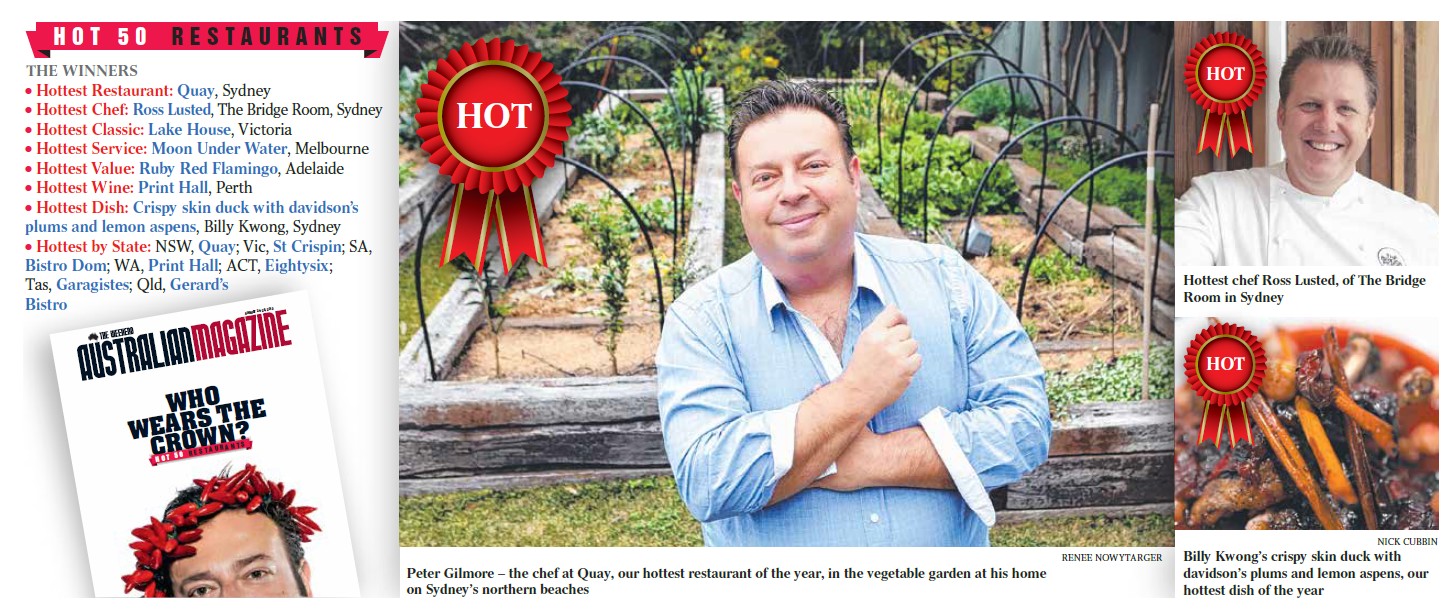Formality forgotten as food rules the new order
Are we at the beginning of the end of formal restaurants? Fine dining has survived many obituaries, but in the past year the facts started catching up with the story.
In Sydney, Claude's closed after 37 years, Guillaume at Bennelong's days are numbered and Becasse went down in a tsunami of debt; in Melbourne, Press Club made way for something more democratic; in Perth, Star Anise ended a long stint; and in Newcastle, Bacchus ended a run as the city's big night out.

Peter Gilmore's restaurant Quay has been named Hottest Restaurant in The Weekend Australian Magazine's Hottest Restaurants 2013.
Yet our Hottest Restaurant for 2013 is the exception to prove the rule. After more than a dozen years at the top of the Sydney dining tree, an unashamedly pricey, big-night-out, no-expenses-spared establishment showed us that classic haute-restaurant traditions of comfort, civility, repose, indulgence and, yes, luxury can still conspire to deliver excitement: provided, of course, the food is up to scratch.
At Quay, the food is somewhat better than that. Chef Peter Gilmore's preternatural talent can be taken as a given; what really makes the difference between Quay and so many other contenders is that Gilmore turns up for work every day.
Yes, we know all the arguments for chefs having multiple restaurants, and none of them is in the diner's interests. Gilmore, as we note in our Hot 50 review of the restaurant in The Weekend Australian Magazine today, is Quay, and everyone who dines there gets a share of that talent.
As our third consecutive edition of Australia's 50 Hottest Restaurants shows, despite everything - notable closures and a relative paucity of significant new openings, especially compared with Victoria - NSW is still the dominant state, with 19 entries, of which four are regional restaurants. (Victoria is second with 11, including one regional.)
NSW also scooped the two most coveted awards: Hottest Restaurant and Hottest Chef (Ross Lusted, the Bridge Room), and one other for Hottest Dish (crispy-skin duck, Billy Kwong).
Strong regional showings helped South Australia (six entries, up from four) and Queensland (seven, up from five) lift their game from the previous year.
Nationally, some trends were impossible to ignore. More than anything, diners are demanding value, and restaurateurs are taking increasingly desperate measures to meet that demand. First they whisked the linen off the tables, then cancelled the bookings; now they're shrinking the menu (the carefully curated limited-choice menu is de rigueur at certain fashionable places) and portion sizes, cutting back on table service, making heroes of vegetables and cheaper meats and fish, whacking big markups on the wine list where they may not be noticed (now is a good time to be a teetotaller) and even taking away our bread basket. Ouch.

FULL LIST: Hot 50 Restaurants 2013
Increasingly, too, they're not opening restaurants at all: hence the proliferation of cafe-style eateries and wine bars with high-quality, restaurant-style food.
When the going gets tough, the tough get cooking: we were impressed by those who, fired by youth and creative energy, have opened their own small establishments in defiance of toxic economic conditions. Places such as St Crispin and Town Mouse in Melbourne; Russo & Russo in Sydney; Ruby Red Flamingo in Adelaide; and Gerard's Bistro in Brisbane. There are exceptions. We visited a few top-end, big-name restaurants charging sky-high prices for OK food to a submissive audience of the ostentatiously wealthy. They were not restaurants that made our list.
Shop around carefully, however, and it's still a diner's market. Like most markets, though, things can get a little boisterous at rush hour. Where once we went out for dinner and conversation, now, for better or worse, at a growing number of places it's really all about dinner.
Source: The Australian, 24 August 2013







